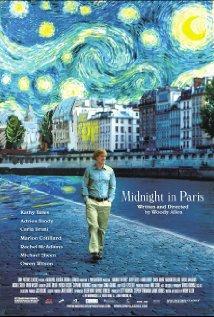

As Roger Ebert says, “There is nothing not to like about this film.” Indeed. From my first viewing, I was thoroughly charmed.
Midnight in Paris (2011) is a pleasant potpourri of literary devices: love, longing, Paris, famous people, and a bit of time travel. Of course, since it’s a Woody Allen film, in some way you can be sure it is about him – don’t all of his films have an autobiographical narcissism? But in this case, it’s easy to look past his doleful eyes and enjoy the film. Owen Wilson (Gil) and Rachel McAdams (Inez) as the leads are pitched just right, and the contrast set up among the other principals is structurally compelling and satisfying. Kathy Bates, Adrian Brody, and others have delightful cameo roles. The time travel device works (besides, it’s Paris and it’s supposed to be a magical city, right?). The story is thoughtful enough and sweetened by some deft brushes of romance. Visually it is artful and alluring – the visual style is part of the idea of the film, and art (something of a composite character) has a voice in the story.
The myth of the golden era. Many of us live in the grip of nostalgia, the desire for something different, the illusion of something better, a sour discontentment. The grass is always greener…. Gil is a screen writer by day who has written a novel. The literature of television is fleeting to him, something so insubstantial it can be switched off. But the world of the novel is enduring and significant in part because it is tied to the past. The problem is that the screen writing pays the bills• the bills Inez is racking up by all her indulgent spending. She cannot imagine that Gil would want something more than what he has, and consequently offers him no encouragement. So, the search for guidance and illumination plays out in the classic city of the arts, Paris. Here, Gil has to find his way. Settling for the way things are in the present, while practical, is a decidedly unfulfilling prospect. Reaching for his ideal is a risk that will require him to let go of some of the security of the present. Gil’s courage to “go for it” is energized by nostalgia, the subject of his novel. He looks back romantically at the icons of a golden era who dared to do what he longs to do. But as he does so he realizes that he can be seduced by romantically idealizing the past, or he can learn from the past, an act that will require humility.
These are important questions for us as Christians. With what perspective do we pursue our life goals? Many of us are trapped by many forms of idealism. Gil looks to the past for salvation even as we do. The historical reality of the Cross, Resurrection, and Ascension are the foundation for all the historical ground which follows. That ground beneath our feet gives us joy and hope. In Christ, the long arm of the past defines the present and persuades us that even in spite of sin the work of Creation continues so that by grace humans can flourish. We can have dreams, and they are worth pursuing.
Woody Allen would say, I think, that Gil is saved by art. We would say, by the Artist. But the role of art, the grace of the Artist, is no less profound for us. The present and the future for us have little significance unless we value the past and humbly learn from it.
-Steve Froehlich


